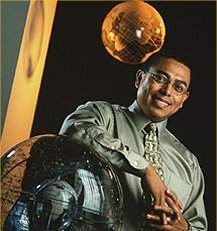Cientistas descobrem como detectar a quarta dimensão do espaçoDa redação26/05/2006
Dois cientistas norte-americanos acabam de publicar uma pesquisa que demonstra como detectar a quarta dimensão do espaço. Somando-se o tempo, passaríamos então a "ver" nosso universo em cinco dimensões. A teoria é, na verdade, um novo modelo para o entendimento da força da gravidade, uma alternativa à Teoria da Relatividade Geral, de Einstein.
A demonstração matemática permitirá que os astrônomos testem a nova teoria da gravidade e as cinco dimensões do universo. Charles R. Keeton e Arlie O. Petters batizaram sua teoria de modelo gravitacional de branas de Randall-Sundrum de tipo II.
A teoria sustenta que o universo visível é uma membrana incorporada em um gigantesco universo, de forma muito parecida com uma alga-marinha flutuando sobre o oceano. Esse "mundobrana" ou "universobrana" tem cinco dimensões - quatro dimensões espaciais mais o tempo - comparado com as quatro dimensões - três espaciais mais o tempo - da Teoria da Relatividade Geral de Einsten.
O modelo matemático apresentado prevê certos efeitos cosmológicos que, se observados, ajudarão os cientistas a validar ou rejeitar a teoria do mundobrana. Segundo eles, as observações poderão ser possíveis com a utilização de um telescópio espacial com lançamento previsto para os próximos anos.
Se comprovada, o impacto de uma nova dimensão não se restringirá à Física. "Ela irá confirmar que há uma quarta dimensão no espaço, o que irá criar uma alteração filosófica em nosso entendimento do mundo natural," diz Petters.
Branas
O modelo de um mundo de branas de Randall-Sundrum - batizado com o nome de seus criadores, Lisa Randall, da Universidade de Harvard e Raman Sundrum, da Universidade Johns Hopkins - consiste em uma descrição matemática de como a gravidade dá forma ao universo, diferindo da explicação dada pela Teoria Geral da Relatividade. A imagem ao lado é uma simulação em computador de como seriam as branas.
Keeton and Petters centraram sua atenção em uma conseqüência gravitacional em especial da teoria do mundobrana, que a distingue da teoria de Einstein.
A teoria do mundobrana prevê que buracos negros relativamente pequenos, criados quando o universo nasceu, sobreviveram até hoje. Os buracos negros, com massa equivalente a um pequeno asteróide, seriam uma parte da matéria escura. Como seu nome sugere, a matéria escura não emite e nem reflete luz, mas exerce uma força gravitacional.
A Teoria da Relatividade Geral, por sua vez, estabelece que esses buracos negros primordiais não existem mais. "Quando nós calculamos a que distância da Terra poderiam estar os buracos negros do mundobrana, ficamos surpresos de descobrir que os mais próximos podem muito bem estar no interior da órbita de Plutão," diz Keeton.
Petters acrescenta: "Se os buracos negros do mundobrana formarem apenas um por cento da matéria escura em nossa parte da galáxia - uma estimativa conservadora - poderá haver milhares desses buracos negros em nosso Sistema Solar."
ComprovaçãoAgora, para comprovar sua teoria de cinco dimensões, os cientistas terão que encontrar esses buracos negros. Eles demonstraram que pode ser possível detectá-los observando a radiação de outras galáxias que está vindo continuamente para a Terra.

Ao passar perto de um corpo com a força gravitacional tão forte quanto um buraco negro, essa radiação é afetada, formando um efeito chamado "lente gravitacional."
Os cientistas estão particularmente interessados nos jatos de raios-gama que vêm em direção à Terra. Raios-gama de alta concentração originam-se, por exemplo, de explosões estelares. Ao passar perto de um buraco negro, esse raios sofreriam um padrão de interferência, que pode ser detectado.
A técnica das lentes gravitacionais ja é comum em astrofísica, sendo utilizada, por exemplo, para se procurar por planetas extrasolares. Mas os cientistas descobriram que a "assinatura" da quarta dimensão espacial também aparece no padrão de interferência captado, surgindo como uma contração entre as "franjas" do padrão.
Segundo os cientistas, o telescópio espacial GLAST ("Gamma-ray Large Area Space Telescope"), a ser lançado em Agosto de 2007, será capaz de medir esse padrão de interferência.
Agora, é só esperar o lançamento do GLAST e aguardar que os cientistas façam suas medições. E, caso a teoria seja comprovada, preparar-se para ver a ciência dando os primeiros passos rumo ao conhecimento de um outro universo, intuído por muitos, mas até agora fugidio e insistentemente se escondendo de nossos mais apurados "sensores".
Fonte:
Inovação Tecnologica